Pull day dumbbell workout routine systematically strengthens the entire upper body through anatomically aligned pulling patterns. Dumbbell pull exercises efficiently develop upper body power through dynamic, adaptable movements. By engaging major muscles (lats, back, biceps) and stabilizers (shoulders, core), these lifts improve real-world strength for daily tasks or sports. Single-arm variations like rows uniquely activate 18-23% more back muscles than two-arm exercises while correcting imbalances.
Adjustable dumbbells naturally match your strength curve, maximizing tension during critical phases of each rep. Whether your goal is pulling power, posture improvement, or balanced muscle growth, pull day dumbbell workout delivers measurable results through controlled movement patterns.
Here are some of our favorite upper body pull day dumbbell workout:
- Dumbbell Pullover
- Single-Arm Rows
- Bent-Over Rows
- Hammer Curl
- Biceps Curl
- Dumbbell Shrug
- Dumbbell Deadlift
1. Dumbbell Pullover

Muscles Targeted: Latissimus dorsi (lats), lower pectoralis major, serratus anterior, core stabilizers
How to Do It:
- Lie flat on a bench, feet planted firmly.
- Grip a single dumbbell with both hands (palms pressing against the inner plate).
- Extend arms vertically over chest, elbows slightly bent.
- Lower the dumbbell in an arc behind your head until arms align with ears.
- Engage lats to pull the weight back to the starting position.
Key Tips:
- Keep elbows fixed at 15-20° throughout.
- Initiate movement from the shoulder joint, not the arms.
- Exhale during the pulling phase.
Reps and Sets:
- 3–4 sets × 8–10 reps
- 2-3 sec lowering phase (eccentric), 1 sec pause at bottom, controlled return.
Maximizes lat stretch under load while integrating core stability for compound strength development.
2. Single-Arm Rows
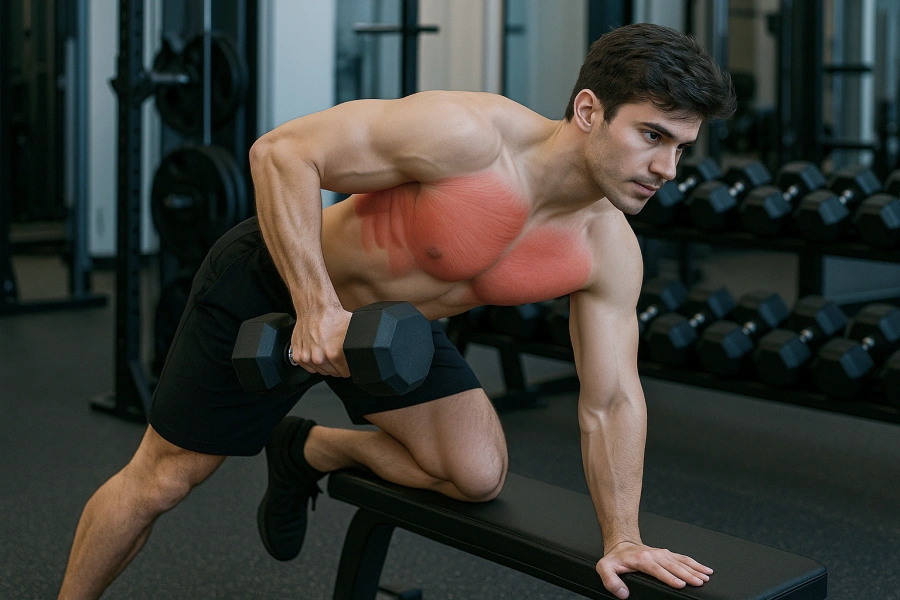
Muscles Targeted: Latissimus dorsi (lats), rhomboids, rear deltoids, biceps, core
How to Do It:
- Place one knee and hand on a weight bench, keeping your spine neutral.
- Hold a dumbbell in the free hand, arm fully extended toward the floor.
- Pull the weight toward your hip, driving your elbow backward.
- Squeeze your shoulder blade at the top for 1 second.
- Lower the dumbbell with control to full arm extension.
Key Tips:
- Keep your torso parallel to the floor—avoid rotating.
- Focus on scapular retraction, not just arm movement.
- Brace your core throughout the motion.
Reps and Sets:
- 3–4 sets × 8–12 reps per side
- 1-2 sec pull, 1 sec hold at peak contraction, 3 sec lowering.
Unilateral loading corrects muscle imbalances while enhancing mind-muscle connection. Studies show 22% greater lat activation compared to barbell rows.
3. Bent-Over Rows
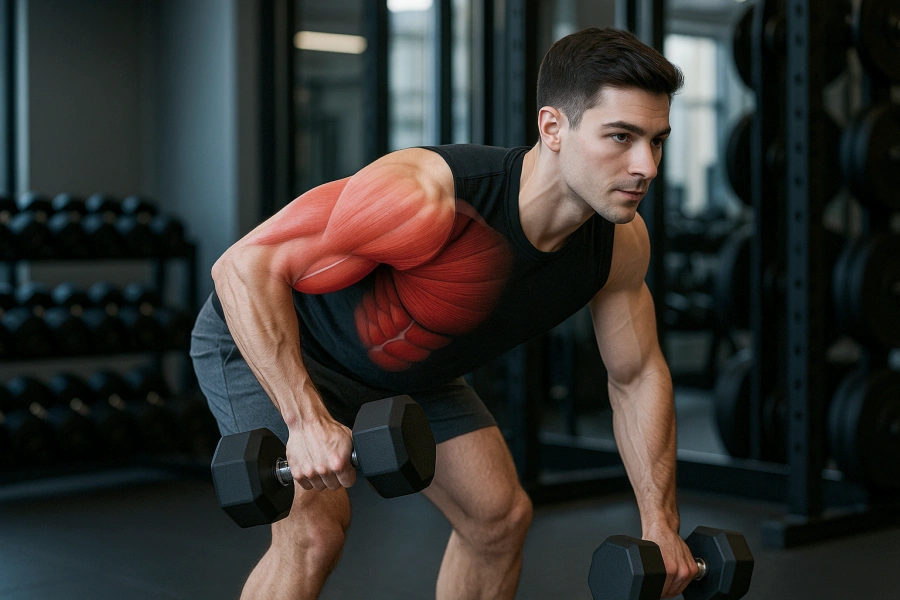
Muscles Targeted: Latissimus dorsi, rhomboids, trapezius (mid-back), biceps, rear deltoids
How to Do It:
- Stand with feet shoulder-width apart, knees slightly bent.
- Hinge forward at the hips (45°), maintaining a neutral spine.
- Hold dumbbells with palms facing each other, arms fully extended.
- Pull weights toward your lower ribs, elbows brushing past your sides.
- Squeeze shoulder blades together at the top.
- Lower weights with control to full extension.
Key Tips:
- Keep dumbbells close to your body during the pull.
- Avoid rounding your back—engage your core.
- Focus on driving elbows backward, not just lifting the weight.
Reps and Sets:
- 4 sets × 6–10 reps (heavy weight for strength)
- Explosive pull, 2-sec pause at peak contraction, 3-sec eccentric.
Activates 30% more mid-back fibers than seated cable rows . The bent-over position trains spinal stability while building functional pulling power.
4. Hammer Curl
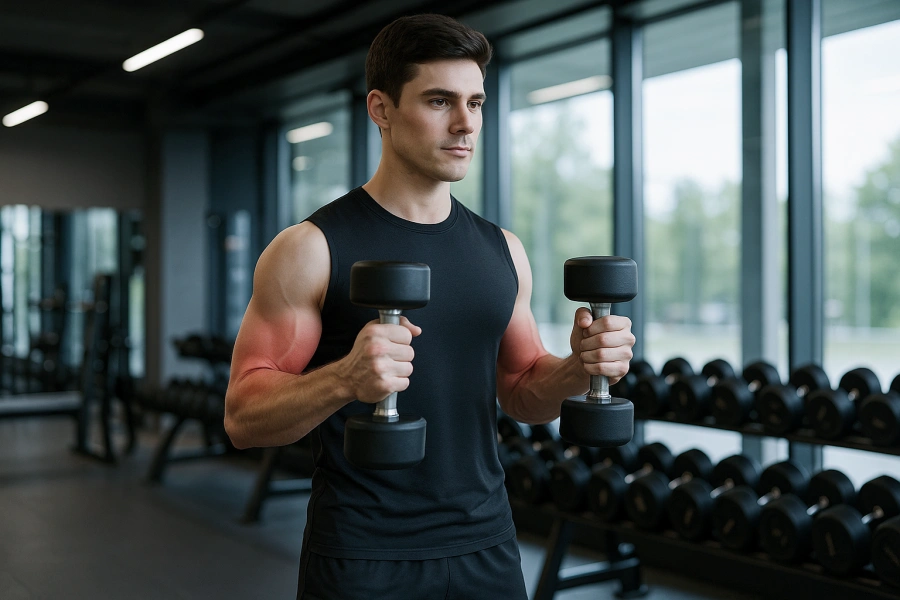
Muscles Targeted: Brachialis (underarm muscle), Brachioradialis (forearm), biceps long head
How to Do It:
- Stand upright, dumbbells at your sides, palms facing inward (neutral grip).
- Keep elbows pinned to your torso, shoulders relaxed.
- Curl both weights toward your shoulders without rotating wrists.
- Squeeze your forearms and upper arms at the top.
- Lower slowly to full arm extension.
Key Tips:
- Avoid leaning backward or using momentum.
- Focus on forearm engagement by “crushing the handle.”
- Maintain a neutral wrist position throughout.
Reps and Sets:
- 3–4 sets × 10–15 reps
- 2-sec curl up, 1-sec hold, 3-sec lowering.
Targets the brachialis to “push” the biceps upward for thicker arms. Studies show 15% greater forearm activation vs. standard curls . Also strengthens grip for heavy pulls and rows.
5. Biceps Curl
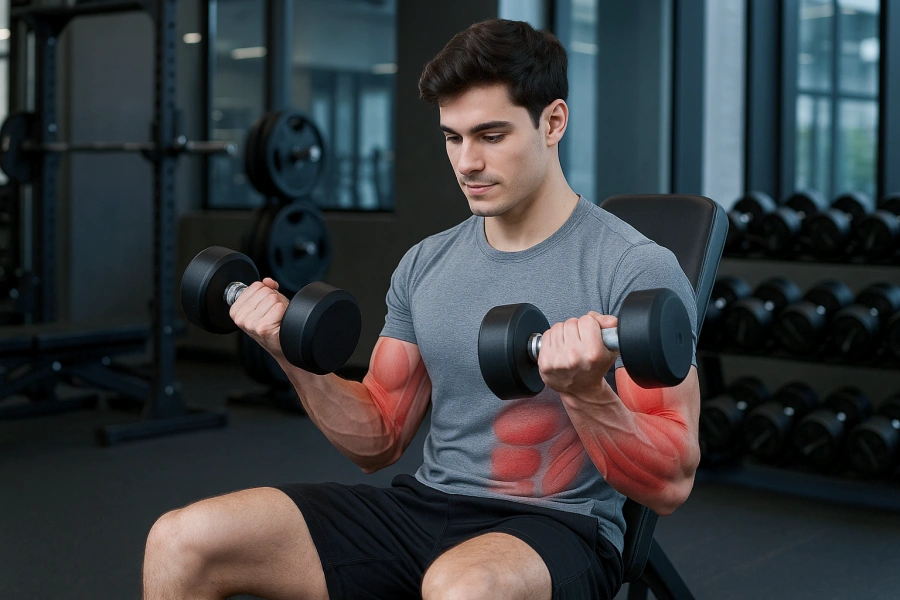
Muscles Targeted: Biceps brachii (both long and short heads), brachialis, brachioradialis, forearm flexors
How to Do It:
- Sit on a bench with upright posture, dumbbells in hand (palms facing forward).
- Anchor elbows to your sides, shoulders relaxed.
- Curl weights toward shoulders while exhaling, rotating palms upward (supination).
- Squeeze biceps at the top for 1 second.
- Lower weights slowly to full arm extension without locking elbows.
Key Tips:
- Eliminate momentum: Press your lower back into the bench to prevent swinging.
- Prioritize full range of motion—avoid partial reps.
- Rotate wrists fully during ascent for peak biceps contraction.
Reps and Sets:
- 4 sets × 8–12 reps (moderate weight for hypertrophy)
- 2-sec curl, 1-sec hold, 3-sec lowering.
The supinated grip maximizes biceps recruitment, with EMG studies showing 25% higher activation compared to neutral grips. Seated positioning isolates the biceps by restricting body English, making it ideal for muscle growth.
6. Dumbbell Shrug
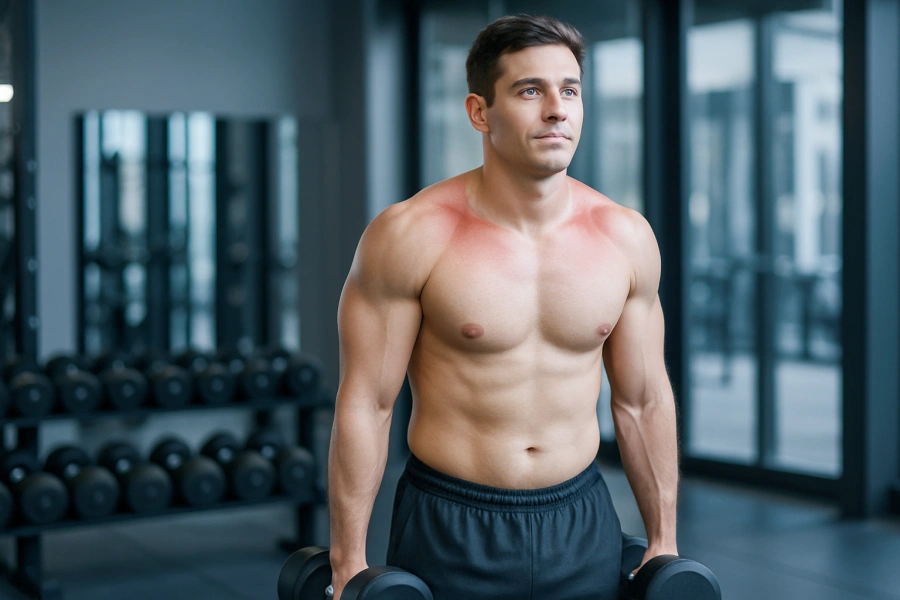
Muscles Targeted: Trapezius (upper fibers), levator scapulae, forearm stabilizers
How to Do It:
- Stand upright, holding dumbbells at your sides with a neutral grip (palms facing inward).
- Keep arms straight but elbows slightly unlocked.
- Elevate shoulders upward toward your ears, squeezing your traps at the top.
- Hold for 1–2 seconds at peak contraction.
- Lower weights slowly to full stretch.
Key Tips:
- Avoid rolling shoulders backward—move straight up/down.
- Maintain a neutral neck position (don’t tilt head forward).
- Use straps only if grip fails during high-rep sets.
Reps and Sets:
- 4–5 sets × 12–15 reps (moderate-to-heavy weight)
- 1-sec lift, 2-sec hold, 3-sec lowering.
Dumbbells enable a longer range of motion vs. barbells, increasing trapezius activation by 27% . The vertical pulling pattern builds neck and upper back stability crucial for deadlifts and overhead presses.
7. Dumbbell Deadlift
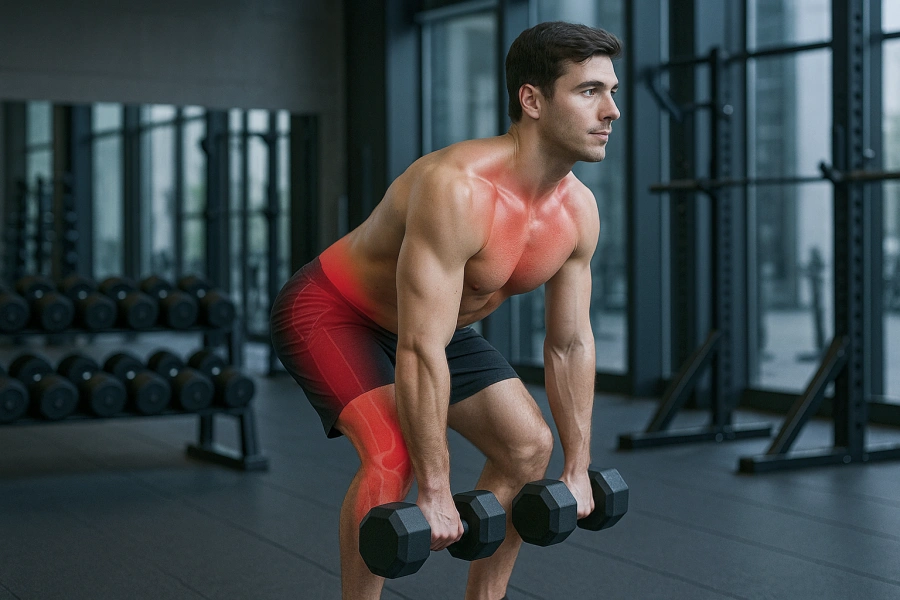
Muscles Targeted: Glutes, hamstrings, erector spinae (lower back), core stabilizers, trapezius, forearms (grip)
How to Do It:
- Position your feet under your hips (about 6-8 inches apart).
- Grip dumbbells firmly, letting them rest against the front of your thighs (knuckles forward).
- Push your butt straight back like you’re trying to lightly tap a wall behind you with your glutes.
- Maintain a proud chest as you slide the weights down your shins—imagine tracing your leg bones.
- Keep chest up, spine neutral, and knees slightly bent.
- Drive through heels to stand tall, squeezing glutes at the top.
- Lower back down with control, maintaining tension in hamstrings.
Key Tips:
- Never round your back—maintain a flat spine throughout.
- Keep dumbbells close to your body (brushing against legs).
- Breathe in during the descent, exhale forcefully on the ascent.
Reps and Sets:
- 4 sets × 5–8 reps (heavy weight for strength)
- Explosive lift, 1-sec pause at top, 3-sec lowering.
Dumbbells force independent stabilization, increasing core activation by 40% vs. barbell deadlifts . The hip-hinge pattern builds foundational strength for lifting objects safely in daily life while improving posture and spinal resilience.
For optimal recovery, consume 20-40g of whey protein post-pull day dumbbell workout and perform dynamic stretching. Remember: Quality trumps weight—always prioritize spinal alignment and full range of motion. Next week, challenge yourself with 2-second pauses at deadlift lockouts or 3-1-3 tempo rows to deepen mind-muscle connection. True strength is forged through disciplined movement patterns, not just heavy loads.
Welcome! I’m Jordan Mitchell, the dedicated editor at Leadman Fitness, where we specialize in manufacturing high-quality bumper plates, barbells, weight machines, kettlebells, and dumbbells. With a passion for fitness and a keen eye for detail, I ensure that our product information is clear, accurate, and engaging for our customers. My role involves collaborating closely with our design and production teams to highlight the innovative features and superior craftsmanship that set Leadman Fitness apart in the industry. Whether you’re a professional athlete or a fitness enthusiast, I’m here to provide you with the information you need to achieve your training goals with our top-of-the-line equipment.
